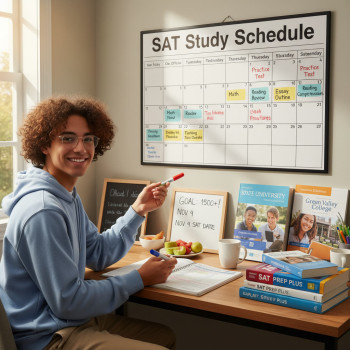Why the Shift from Test Prep to Essay Writing Feels Harder Than It Is
You’ve spent months—or maybe years—memorizing formulas, practicing reading passages, timing math sections on a digital device, and chasing incremental score improvements. Suddenly, your college application says: write about a meaningful experience. No multiple choice. No timer breathing down your neck. Just your voice.
That sudden switch can feel disorienting. The SAT trains precision: how to parse a sentence, eliminate wrong answers quickly, and choose the most efficient path to a solution. A college essay asks for something different: a human voice, reflection, nuance, and a narrative arc. But those SAT-honed skills are not wasted—we’ll unpack exactly how useful they are, how to transfer them, and how to build on them into essays that sound like you (and not like a practiced test-taker).

What You Already Know from SAT Prep That Helps Your Essays
Before you toss your test strategies aside, note this: SAT prep teaches a set of thinking habits that are quietly powerful for essay writing. Here’s how they map over.
Precision of Language
On the SAT, you learn to notice small differences in wording. That sensitivity sharpens your sentence-level choices when you craft an opening line, trim a paragraph, or swap a dull verb for an exact one. A single precise verb or a concrete detail can lift an entire paragraph.
Evidence and Claims
The test rewards answers supported by the passage. College essays reward the same—except your “passage” is your life. You’ll support claims about who you are with concrete moments, not abstract statements.
Structure and Organization
Test strategies train you to spot structure: main ideas, supporting details, and the quickest path to an answer. Use that sense of structure to map your essay’s narrative arc—setup, complication, reflection, and resolution.
Time Management (But Differently Applied)
While essays don’t have the same strict time limits, your SAT habit of working with a schedule helps you plan drafts, feedback sessions, and final polishing without last-minute panic.
Mindset Switch: From “Right Answer” to “True Voice”
The SAT rewards an objective right answer; college essays reward authenticity, clarity, and insight. That’s the mental pivot you need to make. Instead of hunting for the right response, your job is to tell a story that reveals something meaningful about you.
Think of the transition as changing genres. Both genres value clarity and evidence, but essays value vulnerability, choices, and narrative risk. That’s good news: you already have the clarity and evidence skills. Add a little vulnerability and curiosity, and you’re on your way.
Practical Roadmap: How to Move From Practice Tests to a Strong Draft
Here’s a step-by-step approach you can follow. Treat it like an SAT study plan—blocked time, measurable goals, and steady improvement.
- Week 1 — Inventory and Ideas: Spend three focused sessions listing meaningful moments, challenges, passions, and turning points. Don’t judge—just collect. Aim for 30–50 short bullet ideas.
- Week 2 — Choose and Map: Pick 3–5 strongest ideas. For each, answer: What happened? Why did it matter? What changed in me? Then draft a one-paragraph arc.
- Week 3 — First Draft: Write a 400–600 word first draft for your top idea. Don’t edit while writing; focus on flow and honesty.
- Week 4 — Feedback and Revision: Get feedback from a teacher, counselor, parent, or a trusted tutor. Revise for clarity, voice, and specifics.
- Weeks 5–6 — Polish and Target: Tailor your essay to prompts, refine language, and proofread carefully. Read aloud to catch cadence and tone issues.
How Sparkl’s Personalized Tutoring Fits In
Many students find it useful to bring in guidance during Weeks 3–4—someone who can ask the right questions, point out moments that reveal character, and help translate SAT-style concision into narrative warmth. Personalized tutoring—like Sparkl’s one-on-one guidance—can offer tailored study plans, expert tutors who understand the admissions landscape, and AI-driven insights to track progress. A tutor can be especially helpful when you’re stuck between two draft directions or want targeted feedback on voice, structure, and impact.
Choosing the Right Story: Not Every Good Story Is a Good Essay
We all have anecdotes that are funny or dramatic. But the best college essays are not just about events—they’re about the meaning you extract from them. When evaluating a story, ask:
- Does this moment change how I see myself or the world?
- Can I show this through detail, rather than tell it with clichés?
- Will an admissions reader learn something new about me?
Stories that pass these tests are usually small moments that reveal larger values—an argument with a sibling that teaches conflict resolution, a failed project that teaches persistence, or a quiet responsibility that reveals leadership in an unconventional form.
Structure That Works: A Simple Template to Start From
Structure shouldn’t constrict creativity—it should support it. Here’s a reliable template that borrows from the SAT’s clarity and the essay’s need for reflection.
| Section | Purpose | Approx. Length |
|---|---|---|
| Hook / Opening Image | Grab attention with a scene or crisp detail. | 1–3 sentences |
| Inciting Moment | Introduce the small moment or challenge. | 1–2 short paragraphs |
| Development / Actions | Show what you did, thought, or felt. Use specifics. | 2–3 paragraphs |
| Reflection | Connect the moment to growth, values, or future plans. | 1–2 paragraphs |
| Final Line / Look Forward | Leave a resonant last image or insight. | 1–2 sentences |
Example in Mini-Form
Hook: The power went out right before the regional robotics match. I held my soldering iron in the dark and felt my hands decide whether to quit or invent a way forward.
Inciting Moment: The team looked at me—our lead programmer—because my code hadn’t yet synced with the emergency power unit. For the first time, being the smart kid meant being the calm kid.
Actions: I improvised a manual switch, and while the lights were dim, I rewrote a small function on paper, then typed it under the emergency lights. We competed, and we lost one match, but we fixed a system others had labeled broken.
Reflection: That night taught me something about leadership: it isn’t always the biggest idea; often it’s the quiet problem solved when everyone else is panicking. I now look for broken things with curiosity, not fear.
Final Line: I still like the satisfying click of a switch—but I’m more drawn to the quieter circuitry of teamwork and the small fixes that make big things run.
From Analysis to Voice: Use SAT Reading Habits to Deepen Your Essay
Your SAT reading habit—annotating, underlining key details, and identifying a passage’s tone—translates directly into essay craft. When you write, annotate your own draft like a reader would:
- Underline the key detail that proves your claim.
- Label each paragraph’s function: scene, explanation, reflection.
- Check tone: is it conversational, earnest, or overly academic?
This active reading of your own work helps you spot where you’re telling instead of showing, or where a paragraph drifts off-topic.
Common Pitfalls and How SAT Precision Helps You Avoid Them
Here are mistakes students often make when transitioning from test prep to essays, and how to solve them with SAT-style discipline.
- Problem: Overgeneralizing. Avoid abstract claims like “I learned to be a leader.” Instead, use the SAT habit of evidence: show a moment that proves leadership.
- Problem: Vague language. SAT practice trains specificity. Replace “many people” with “my robotics team of eight” or “my AP US History class of 32.”
- Problem: Losing focus. Keep a single through-line. If your essay opens with a soccer game but ends on volunteer work without connection, rework the link or choose a different story.
- Problem: Overcorrecting for tone. Students sometimes write what they think admissions want—grand statements and big claims. Use the SAT’s reading-of-tone skill to keep your voice authentic and proportionate to the story.
Polishing Techniques: From Draft to Final Copy
The polish phase is where SAT test-taking discipline shines. Use measurable checks similar to how you’d score a practice test.
- Read aloud for flow—mark lines that stumble.
- Count concrete details—aim for at least three vivid specifics in the body.
- Trim filler—search and remove vague qualifiers like very, really, actually.
- Check sentence variety—mix short and long sentences for rhythm.
- Proofread for grammatical precision: punctuation, subject-verb agreement, and parallel structure.
Checklist Table: Final Read-Through
| Item | Yes / No | Notes |
|---|---|---|
| Opening hooks the reader | ||
| Specific moments support my main claim | ||
| Reflection connects experience to growth | ||
| Final sentence leaves a clear impression | ||
| No grammar or punctuation mistakes |
How to Tailor Essays for Different Prompts
Prompts come in different flavors: the reflective personal statement, the activity-specific supplement, or the short-answer “why us” question. Apply the same SAT skill of reading the prompt carefully—annotate what it asks, underline the action words (explain, describe, reflect), and map which part of your experience answers it best.
- Reflective prompts: Emphasize growth and insight.
- Activity prompts: Focus on contribution and learning.
- Why-us prompts: Be specific about programs or opportunities that match your goals; avoid vague praise.
When to Ask for Help—and What to Expect
Feedback is essential, but the right feedback matters. Avoid too many cooks; limit major drafts to two or three people who understand college essays. A helpful set of readers includes:
- A teacher who knows you academically and can comment on intellectual curiosity.
- A counselor who understands how your essay fits the whole application.
- An experienced tutor or editor who can ask hard questions about clarity and voice.
Personalized tutoring services—such as Sparkl—can be helpful because they offer tailored study plans and one-on-one guidance. An experienced tutor can help you translate SAT-style strengths into narrative choices and provide structured, actionable feedback rather than vague praise.
Examples: Before and After Edits
Seeing revision in action clarifies the process. Below are two short examples showing how to move from testy precision to human warmth.
Example A — Before
“I led my robotics team and improved our coding practices. This helped us win more matches and demonstrate leadership. I learned to manage time.”
Example A — After
“The battery died two minutes before our match. With solder smoke and a blinking scoreboard, I rewrote the code on scraps of paper and taught Mia how to tie the temporary jumper cables. We didn’t win every match that day, but the robot moved when it mattered. Leading, I learned, is less about trophies and more about steady hands under pressure.”
Notice the difference: the second version uses a scene, names, and a reflection that reveals character.
Balancing SAT Scores and Essays in College Applications
Admissions officers consider multiple pieces of your application. A strong SAT score can open doors, but your essay gives context—who you are beyond numbers. Think of SAT scores as a measured skill gauge and essays as the personality and story that fill in the human picture.
If your scores are your strongest asset, use essays to show depth and fit with your future plans. If your scores don’t reflect your potential, essays can explain circumstances, demonstrate resilience, and highlight growth.
Final Thoughts: Make the Transition With Intention
Transitioning from SAT prep to college essays is not a leap into a foreign language—it’s a shift in purpose. Keep the analytical habits you developed for the SAT: close reading, precise language, and structured thinking. Layer on vulnerability, scene-based storytelling, and reflection. Give yourself time—good essays rarely appear in an evening—and seek feedback that helps you preserve your voice.
Most importantly, remember that your essay is an invitation to a conversation. It’s a chance to let a reader meet the version of you that doesn’t fit into multiple choice boxes: thoughtful, curious, messy at times, and ready to grow. Take what you learned from digital SAT prep—discipline, clarity, and strategy—and use it to tell a story that only you can tell.

Quick Resources & Next Steps (Your Two-Week Action Plan)
If you’re ready to act, here’s a compact plan to move from SAT prep mode to essay mode in two weeks:
- Day 1–3: Brainstorm freely for 45 minutes each day. No editing.
- Day 4–6: Select top 3 ideas. Write one-paragraph outlines for each.
- Day 7–10: Draft your strongest idea into 500–650 words.
- Day 11–12: Get targeted feedback (one teacher + one tutor or mentor).
- Day 13–14: Revise, proofread, and finalize. Read aloud and make final word trims.
If you want guided, personalized help during these two weeks—from building your outline to final polish—consider scheduling a few one-on-one sessions. Structured tutoring can compress the learning curve and provide the focused, prompt-specific feedback that makes an essay stand out.
Parting Note — Your Story Is Your Data
In the era of digital testing and data-driven admissions tools, human stories remain the most compelling form of evidence. Your SAT scores tell colleges what you’ve mastered. Your essay tells them who you are in context of that mastery. Treat your experience the way you treated SAT passages: read it closely, highlight the details, test interpretations, and revise until what remains is honest, clear, and true to you.
That combination—rigor and heart—is your edge. Use it well.


















No Comments
Leave a comment Cancel